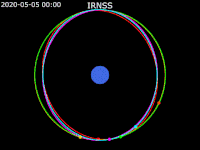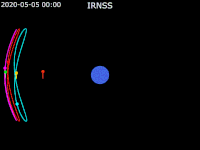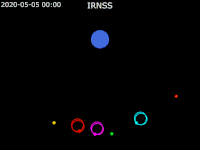 | |
| Mission type | Navigation |
|---|---|
| Operator | ISRO |
| COSPAR ID | 2016-027A |
| SATCAT no. | 41469 |
| Mission duration | 12 years |
| Spacecraft properties | |
| Spacecraft | IRNSS-1G |
| Spacecraft type | Satellite |
| Bus | I-1K |
| Manufacturer | ISRO Satellite Centre Space Applications Centre |
| Launch mass | 1,425 kilograms (3,142 lb) |
| Dry mass | 598 kilograms (1,318 lb) |
| Power | 1600 W |
| Start of mission | |
| Launch date | 12:50:00, April 28, 2016 (UTC+05:30) (2016-04-28T12:50:00UTC+05:30) |
| Rocket | PSLV-XL C33 |
| Launch site | Satish Dhawan (First) |
| Contractor | ISRO |
| Orbital parameters | |
| Reference system | Geocentric |
| Regime | Geosynchronous Orbit (GSO) |
| Longitude | 129.429213 East |
| Perigee altitude | 35,780.961 km (22,233.258 mi) |
| Apogee altitude | 35,796.200 km (22,242.727 mi) |
| Inclination | 4.2637 |
| Period | 23:56:12.33 |
| Epoch | 17151.68965311 |
| NavIC← IRNSS-1FIRNSS-1H → | |
IRNSS-1G was the seventh and final of the Indian Regional Navigation Satellite System (IRNSS) series of satellites after IRNSS-1A, IRNSS-1B, IRNSS-1C, IRNSS-1D, IRNSS-1E and IRNSS-1F. This system of satellites will provide navigational services to the Indian region. The satellite was launched successfully on 28 April 2016 at 07:20 UTC.
IRNSS-1G along IRNSS-1A is being used only for NavIC's short message broadcast service and not for navigation.
Launch
The satellite was launched from the First Launch Pad (FLP) of Satish Dhawan Space Centre, Sriharikota on board PSLV-C33 XL on 28 April 2016 at 12:50 PM IST. The countdown of the launch had begun 51:30 hours before at 9:20 AM IST on 25 April 2016.
After the launch of IRNSS-1G the Indian government named the IRNSS system as NAVIC (Navigation with Indian Constellation).
Specifications
Mission life: 12 years (planned).
Lift-off mass:1,425 kilograms (3,142 lb)
Dry mass: 598 kilograms (1,318 lb).
Payload: CDMA ranging payload in C band. Navigation payload in L-5 and S band spectrums and Rubidium atomic clocks.
Power: Two triple-junction solar panels to generate 1660W of energy and one Lithium-ion 90A-hr battery is used.
Propulsion: MMH/MON3 based bipropellant system with 12×22N Attitude control thrusters and one 440N LAM.
Orbit: Geosynchronous orbit at 129.5° East longitude with 5° inclination.
Cost: Approximately ₹125 crore (US$15 million).
Animation of IRNSS Around the Earth
Around the Earth Around the Earth - Polar view
Around the Earth - Polar view Earth fixed frame - Equatorial view, front
Earth fixed frame - Equatorial view, front Earth fixed frame - Equatorial view, side
Earth fixed frame - Equatorial view, side Earth fixed frame - Polar view Earth · IRNSS-1B · IRNSS-1C · IRNSS-1E · IRNSS-1F · IRNSS-1G · IRNSS-1I
Earth fixed frame - Polar view Earth · IRNSS-1B · IRNSS-1C · IRNSS-1E · IRNSS-1F · IRNSS-1G · IRNSS-1I
See also
- Communication-Centric Intelligence Satellite (CCI-Sat)
- GPS-aided geo-augmented navigation (GAGAN)
- Satellite navigation
References
- ^ "NORAD Catalog Number 41469". NORAD. Retrieved 2 June 2017.
- ^ "India launches seventh navigation satellite, to get its own GPS". The Hindu. 28 April 2016. Retrieved 28 April 2016.
- "Annual Report 2019-20". Department of Space. Archived from the original on 6 April 2020. Retrieved 5 March 2020.
- "ANNUAL REPORT 2020-2021" (PDF). ISRO. Archived from the original (PDF) on 25 April 2021. Retrieved 6 March 2021.
- "PSLV-C33/IRNSS-1G". ISRO. Archived from the original on 28 April 2016. Retrieved 28 April 2016.
- ^ PTI (26 April 2016). "Countdown for IRNSS-1G launch begins at Sriharikota". The Hindu. Retrieved 28 April 2016.
- "PSLV-C33 Successfully Launches India's Seventh Navigation Satellite IRNSS-1G - ISRO". www.isro.gov.in. Archived from the original on 1 November 2021. Retrieved 1 November 2021.
- ^ "PSLV-C33 - IRNSS-1G Specifications" (PDF). ISRO. Archived from the original (PDF) on 25 April 2016. Retrieved 28 April 2016.
- "'Isro launches rocket carrying India's seventh navigation satellite'". Business Standard. 28 April 2016. Retrieved 28 April 2016.
- ^ "SALIENT FEATURES OF IRNSS 1G". www.ursc.gov.in. Retrieved 1 November 2021.
- "IRNSS-1G". ISRO. Archived from the original on 24 April 2016. Retrieved 28 April 2016.
- Sangeeta Ojha (28 April 2016). "India's own navigation satellite IRNSS-1G launched: All you need to know about it". India Today. Retrieved 28 April 2016.
- Vanita Srivastava (1 May 2016). "IRNSS: Desi GPS to liberate India from dependence on US, Russia". Economic Times. Retrieved 2 May 2016.
External links
| Navigation with Indian Constellation (NavIC) | ||
|---|---|---|
| Satellites |  | |
| Related articles | ||
| Indian spacecraft | ||||||||||||
|---|---|---|---|---|---|---|---|---|---|---|---|---|
| Satellites |
|  | ||||||||||
| Space probes |
| |||||||||||
| Human spaceflight | ||||||||||||
| ||||||||||||
| ← 2015Orbital launches in 20162017 → | |
|---|---|
| January | |
| February | |
| March | |
| April | |
| May | |
| June | |
| July | |
| August | |
| September | |
| October | |
| November |
|
| December |
|
| Launches are separated by dots ( • ), payloads by commas ( , ), multiple names for the same satellite by slashes ( / ). Crewed flights are underlined. Launch failures are marked with the † sign. Payloads deployed from other spacecraft are (enclosed in parentheses). | |